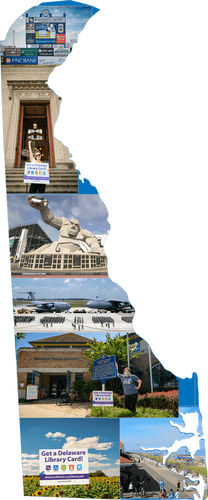
Community Definition and Identity
Our community is the State of Delaware: 2,490 square miles of land in the Mid-Atlantic region, the second smallest state with the 6th highest population density in the U.S (just under 1 million people). Several major cities are a short drive or Amtrak ride away including Philadelphia PA, Washington DC, Baltimore MD and New York City (Figure 1). Delaware contains three counties from north to south. New Castle County (north) is home to the City of Wilmington, the largest city in the state. The suburban/rural, Kent County (central) is the home of the capital, Dover, and Kent County Dover Air Force Base, the Department of Defense’s largest aerial port and mortuary facility. Sussex County (south) is the largest county east of the Mississippi, with a more rural and agricultural western side contrasting with the tourist destination beaches on the east coast.
-
Population: 989,948 and the 13th fastest growing state at a rate of 10.2%, outpacing its Mid-Atlantic and Northeast neighbors, with Sussex County gaining the most population in the 2020 census.
-
Delaware’s population demographics are 68.75% white, 22.11% Black or African American, 3.87% Asian, 2.75% two or more races, 1.9% Other races, and 0.36% Native American. Delaware ranks as one of the top ten states when it comes to the proportion of African American residents compared to the total population.

Delaware is known as the First State because we were the first state to ratify the Constitution of the United States. We love being first. Delaware is known for chemicals, cars, corporations, chickens, and credit cards, and we are a nationwide leader in fintech. Sixty-eight percent of Fortune 500 companies are incorporated in Delaware. We are known as the “Home of Tax-Free Shopping!” Combined with low property taxes (7th lowest in the nation), Delaware often ranks high on national best retirement location lists, leading to an increasingly older population, especially in Sussex County. Historically, Delaware’s state services were supported by state corporate taxes, and Delaware continues to offer most basic services at the state level to keep cost low. We are known for our recreation and tourism destinations such as our Atlantic Beaches, including Rehoboth Beach, the nation’s Summer Capital.
We have a high number of private schools, and a mix of public and charter schools. The percentage of Delaware third graders reading at grade level has decreased from 54% in 2015 to 35% in 2021. While Delaware ranks third in the nation for internet speed, there still are areas across the state with limited to no access. The federal Affordable Connectivity Program (ACP) and Broadband Equity, Access, and Deployment (BEAD) Program will help fill those gaps in the coming years. We have a high number of nonprofits in Delaware (2,000 – 3,000), many of which partner with state and local government agencies to provide services to our residents. In 2019, Delaware’s poverty rate was 11.3%, compared to the national rate of 10.5%.
We are small, and our culture values relationships. We know each other, the lore is one degree (or less) of separation. We know our public officials, including the 46th President Joe Biden. Due to economic changes over the last few decades, including the loss of car manufacturing and the downsizing of chemical and credit card companies, our Governor’s priority is “Strengthening DE’s Economy,” with an emphasis on improving grade level reading and early childhood literacy.
By capitalizing on our small size, the love of being first, and interconnections, our COE group’s focus is improving literacy levels in Delaware because the ability to read, write, and speak in English, as well as compute, and solve problems, are necessary to function on the job, within the family, and in society. A recent study shows that 1 in 5 adults in Delaware are reading at or below a 3rd grade level, and we rank 30th nationwide in adult literacy proficiency. Many Delaware adults who are unemployed or underemployed due to low literacy skills do not have a taxable income; do not have the income to buy homes, cars, and other essentials; and rely on social safety nets, which influence government-spending needs.
Key Challenges and Advantages
| Advantages | Challenges |
|---|---|
| 33 public libraries: proximity | Siloed/unknown fragmentation of data - Partners and Owned Participants |
| Existing connections: foundation | Adult literacy: recognizing as an issue |
| Communication strategy | Broad lifelong literacy effort |
| Strong foundation | Poverty |
| Large literacy resource footprint | Awareness, education, engagement- connectivity; purposeful collaboration with partners & libraries |
| Willingness around early childhood | Flooded with initiatives |
| Strong digital, workforce, economic mobility | Access to real time data |
| All ages | Affordable dashboard, data collection and analysis solution |
| High level of trust | Coordination across state departments is currently ad hoc, not systematic or sustainable |
| Accessible political arena | |
| Support from Government Efficency & Accountablity Review Board (GEAR) and Delaware Quality Partnership (DQP) |


